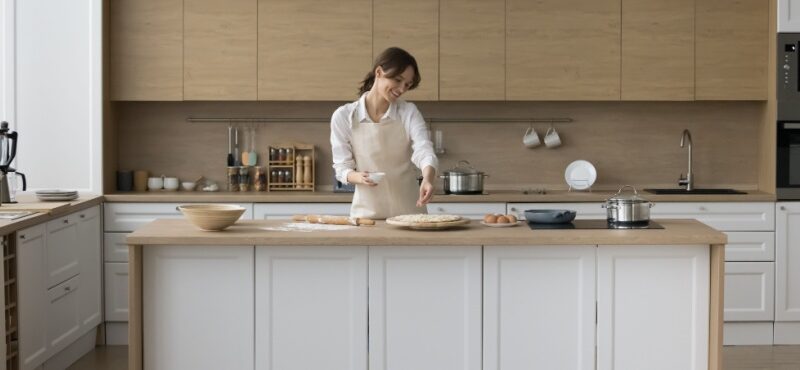Designing a kitchen that feels balanced, stylish, and inviting starts with one essential principle: cohesion. Your cabinets, flooring, and countertops are the three dominant surfaces in the room, and how they interact can make or break the overall look. Whether you prefer a sleek modern space or a warm traditional design, choosing complementary finishes and materials is key to creating a harmonious kitchen. Today we’ll be walking you through how to match your cabinets, flooring, and granite countertops to achieve a seamless and visually pleasing design.
Start with Your Cabinet Color
Since cabinets often take up the most visual space in the kitchen, they usually serve as the foundation for the rest of the design. If you’re starting fresh, think about the mood you want your kitchen to convey. Light-colored cabinets—such as white, soft gray, or cream—create a bright, open atmosphere and work well in smaller kitchens. Darker cabinets like espresso, navy, or forest green offer depth and drama, ideal for larger spaces or bold design statements.
Wholesale kitchen cabinets come in a variety of shades and finishes, so choose one that aligns with your personal style and the size of your space. Once your cabinet color is selected, you can begin building the rest of your palette around it.
Coordinate Flooring with Cabinet Tone
Your flooring and cabinets should work together, not compete for attention. When pairing them, aim for either contrast or subtle tonal variation. For example, if you choose dark cabinets, consider lighter flooring—such as natural wood, stone-look tile, or light luxury vinyl—to balance out the richness of the cabinetry. This contrast keeps the space feeling open and visually dynamic.
For light-colored cabinets, warm or mid-toned floors help ground the space and create an inviting feel. Avoid selecting flooring that’s too close in color to your cabinets, as this can cause the kitchen to appear flat or washed out. Instead, look for finishes that differ slightly in tone or texture to create depth.
Wood flooring or wood-look options pair especially well with painted or stained cabinets, adding warmth and a natural element that complements the cabinetry’s finish.
Choose a Granite Countertop That Ties It Together
Once you’ve chosen your cabinets and flooring, the next step is selecting a granite countertop that bridges the gap between them. Granite comes in a wide variety of patterns and color combinations, making it an ideal surface to unify your kitchen design.
Look for granite slabs that feature tones from both your cabinet and flooring choices. For example, if you have white shaker cabinets and medium oak floors, a granite like Giallo Ornamental—which features soft creams and warm flecks—can pull the two together beautifully. If your kitchen includes gray flooring and dark cabinetry, a countertop like Alaska White or River White can provide contrast while including subtle veining that matches both elements.
Avoid granite patterns that clash too heavily with either the flooring or cabinetry. Instead, aim for countertops that enhance and echo existing tones to create a seamless, intentional flow.
Don’t Forget Texture and Finish
Color coordination is crucial, but texture and finish also play an important role in kitchen cohesion. Matte cabinets pair well with natural wood or textured tile floors, while glossy cabinets often complement polished granite and sleeker flooring materials.
If your cabinets have a smooth, uniform finish, consider choosing a granite with a subtle pattern to add movement without overwhelming the space. On the other hand, if your cabinets feature a distinct grain or texture, opt for granite with a more consistent tone to maintain balance.
The sheen of your flooring, cabinetry, and countertops should also be considered. Combining high-gloss cabinets with shiny flooring and polished granite can feel too reflective, while pairing a variety of finishes—like matte cabinets with a polished granite countertop and satin-finish floors—adds depth and visual interest.
Create Visual Continuity with Accent Elements
To further unify your design, incorporate accent pieces that reflect your core color palette. Backsplashes, hardware, lighting fixtures, and even barstools can be chosen to echo the tones found in your cabinetry, flooring, and granite. These details can help tie the space together and make the transition between surfaces feel more intentional.
For example, a tile backsplash that features flecks of your granite’s veining or a brushed gold handle that complements the warmth of your flooring can subtly reinforce cohesion throughout the room.
Build a Kitchen That Feels Balanced and Beautiful
Creating a cohesive kitchen doesn’t mean everything has to match perfectly—it means everything works together harmoniously. By starting with your cabinet color, selecting flooring that contrasts or complements it, and choosing a granite countertop that pulls the palette together, you can design a kitchen that feels thoughtful, inviting, and visually balanced.
At Tops Kitchen Cabinet, we offer a wide variety of wholesale kitchen cabinets and granite countertops to help you achieve the perfect look for your space. Ready to design a kitchen that feels as good as it looks? Visit our website to contact us and let us help you bring your vision to life with high-quality materials at unbeatable value.

